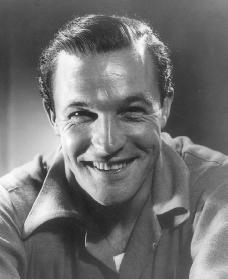- Gene Kelly
 |
| Headshot of Gene Kelly Library of Congress / (CC BY-NC-SA 2.0) via Flickr |
When most people hear the name Gene Kelly they generally think of the male lead tap dancer from the “ancient” movie musical Singin’ In the Rain. But Gene Kelly was much more than the dancer from that movie. He was a dancing engineer; he was able to bring dance to the screen; he was able to cope with sadness in his life; and, last but not least, he is my hero.
Before Gene Kelly tapped in the rain, he was a dance teacher. When he was a small child his mother had taught him and his four siblings how to dance and she opened up a dance studio in which Gene taught. He and his siblings also performed together as “The Five Kellys” or “The Kelly Brothers.” During his schooling, Gene concentrated more on athletics rather than dance. But his athleticism helped strengthen his dancing ability. After graduating from college, Gene went on to be a teacher but he disliked that job because he found it to be too difficult. So he went to Broadway.
On Broadway, Kelly was in many shows, including some with Mary Martin, a famous stage actress who is best known for her role as Nellie Forbush in South Pacific. But his big break came with Pal Joey when Kelly was chosen to star as Joey Evans. During this major debut, his new dance form was presented. It was modern American dance that was not just for entertainment but told a story through all of the actions. He also had lots of energy that he brought to the stage. The show became a smash and was on stage for 270 performances. Kelly was in more Broadway shows until he was offered a contract in California. Before he left though, he married a young dancer from Broadway, Betsy Blair, on September, 1941.
In Hollywood, Kelly’s first movie debut was For Me and My Gal, co-starring Judy Garland. Judy taught Kelly all of the tricks of the trade, because Gene found it difficult to adjust to film. The movie was very successful and next Gene was in Cover Girl. In one scene in Cover Girl, Kelly dances with his alter ego, which is really himself. This was a new innovation for the filming of dance. His next hit was Anchors Aweigh with Frank Sinatra. Kelly was nominated for an Academy Award for his part. In Anchors Aweigh, Kelly danced with the cartoon character Jerry the Mouse. This was also a new innovation because animation and dance had never been filmed that way before.
 |
| Gene Kelly Willy Rizzo / (CC BY-NC 2.0) via Flickr |
Next, Gene enlisted in the Navy because he wanted to serve his country in World War II, and after serving for five years he returned to Hollywood. Back in Hollywood, he participated mostly in movie musicals. His next major musical was An American in Paris. This movie was extremely popular and was another innovation in dance and film. There were scenes in An American in Paris that were extremely artistic and the movement of the dancers explained the story. This had never been done before and, with the help of Gene Kelly, the dance scenes were shot perfectly so that every angle helped present the dance in a positive way.
After An American in Paris, Kelly went on to star in the major movie of his career, Singin’ in the Rain. Scenes in this were very similar to those in An American in Paris because of the artistic quality and dance technique. Due to an income tax law, Kelly’s next stop was Europe. While in Europe Kelly filmed many movies, all of which flopped. When he finally returned to the states, his next films, those he co-directed and those he starred in flopped as well. After the flop of It’s Always Fair Weather, Kelly’s wife Betsy called for divorce. Soon afterwards, Kelly’s contract with MGM went ended, his last film with them being Les Girls.
In 1960, Kelly married Jeannie Coyne and they both had two children. After this marriage, he spent most of his time directing movies. But in 1973, Jeannie died of cancer. In order to raise his kids, Kelly cut down on the amount of jobs he had and did not accept any that were too far away. Kelly did not do very much from this point until his death, but he did win the Kennedy Center Honors and a lifetime achievement award from the American Film Institute. He remarried in 1990 to Patricia Ward. On February 2, 1996, Gene Kelly died of multiple strokes.
The death of his wife Jeannie and his divorce of his wife Betsy was extremely heartbreaking to Kelly. He was emotionally affected due to this and because of Jeannie’s death he was left to take care of his two children. Being able to recover from the devastation of that loss and sacrificing important job opportunities in order to take care of his children is a positive attribute to his character.
Gene Kelly is my hero because he was able to artistically represent dance on film and he created a whole new form of dance. He was also a soldier, and he battled in the Navy. He was able to overcome the sorrow that comes with the loss of his loved ones. Gene Kelly is my hero for all of these reasons and through his dance he will live on and become the hero of more generations to come.
Page created on 8/24/2012 10:32:48 AM
Last edited 8/24/2020 9:37:11 PM
"Kelly, Eugene Curren Biography - S9.com." Biographical Dictionary - S9.com. Web. 23 Nov. 2010 "American Masters . Gene Kelly | PBS." PBS: Public Broadcasting Service. 8 June 2006. Web. 18 Nov. 2010.
